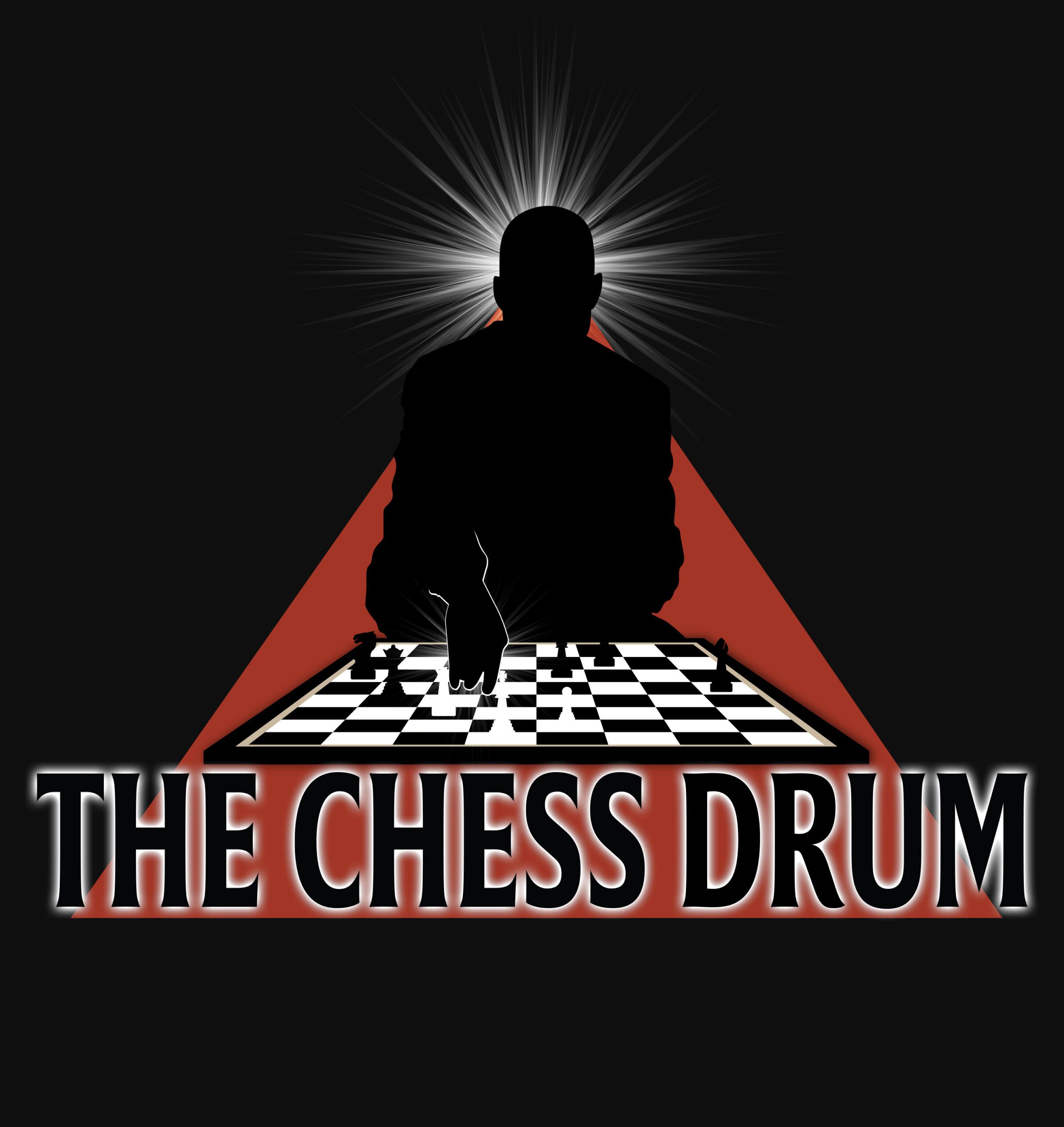Is there still magic at the World Open?
The World Open has been a fixture in the American chess circuit for 47 editions. Bill Goichberg and his staff have turned it into a franchise, and it remains a big draw. The tournament routinely draws 1000+ players from around the world hence the tournament’s name. There was always an intrigue to see who will show up from one year to the next.
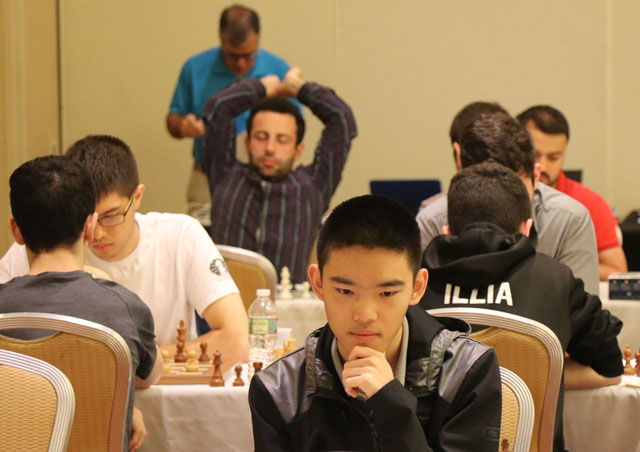
The talented Jeffery Xiong represents the new face of open tournaments in the U.S. These tournaments have been overtaken by young, well-prepared and fearless scholastic and collegiate players. Photo by Daaim Shabazz
In 2003, I ran an article titled, “The Magic of the World Open.” In that article I wrote,
The playing site is a literal festival as players and their guests are milling about. The electricity can be felt from excitement. Many reunions are made between players who have not seen each other since the last World Open or perhaps many years. There is always smile, laughter and excitement… at least in the beginning of the tournament.
I continued…
During the tournament, there is the usual “star-gazing” at some of the world’s best chess players. It is interesting to see Grandmasters enter the skittles room to analyze a game in full view. This type of accessibility is usually not afforded to the average player, but the conditions of the hotel make it possible. The food vendors outside the playing area also add to the informal atmosphere as all types of players fill up on hotdogs, pizza, chips and soda in between rounds. After the tournament last year, GM Maurice Ashley took off his suit and was seen playing hacky-sack with a group of his fans. He then played a round of pickup soccer outside the hotel! At what other U.S. tournament can you have this type of atmosphere?

Philadelphia’s Adams Mark
This tournament was also (and still is) a tournament of dreams. Many players aspire to win a five-figure prize, but also to earn norms or walk away with a heap of rating points. If not that, there is always the social side of it. The old Adams Mark Hotel had a nostalgic feel and was perfect for such an event. There was plenty of room for socializing, and there was not usually a problem with noise in the playing hall. Of course, this was before the massive surge in scholastic players at open tournaments.
I have been to about 20 World Open tournaments, including a couple where I was a spectator. The first visit was in 1990 when I tagged along with Jerry Bibuld and Maurice Ashley during the summer I lived in New York. It was important because I saw a number of Black masters including Wilbert Paige, Alfred Carlin, and Norman Rogers for the first time. Emory Tate and Stephen Muhammad were also there. It was also at this tournament that I revealed my plan for starting a communication vehicle that would later become The Chess Drum.
I have fond memories of the old Adams Mark site which carried a mystique. The skittles room was always on fire and something interesting going on like a blitz battle between GMs, friendly reunions or one of Emory Tate’s theatrical postmortems. I will never forget the postmortem of his game with Sergey Kudrin, a 24-move crush of the strong GM. There was a coliseum of players watching his entertaining display, and afterward, he received generous applause.
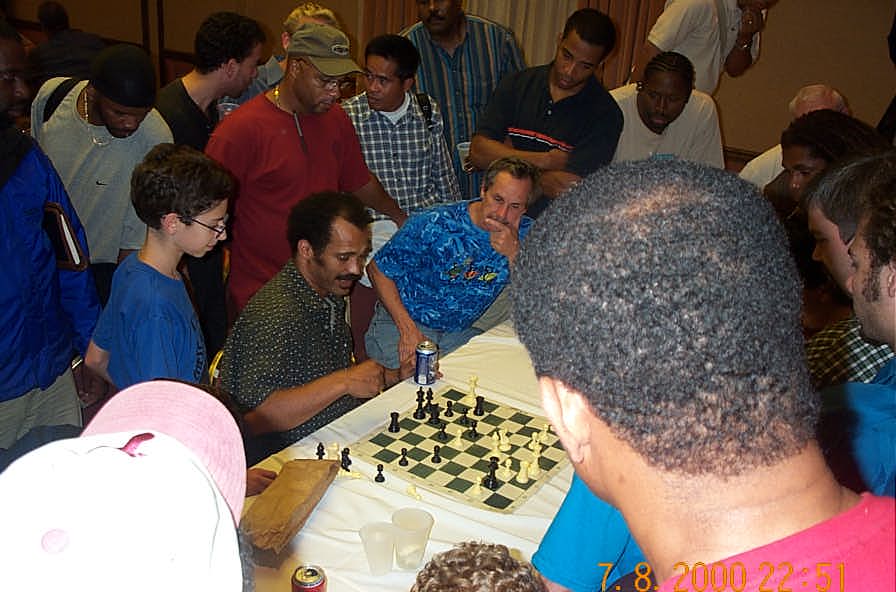
FM Emory Tate showing Kudrin-Tate at 2000 World Open. There were easily 30 people watching. This photo was taken standing on a chair. The audience remained at rapt attention up until the last move. As he rose to leave the room, a thunderous applause broke out! Photo by Daaim Shabazz.
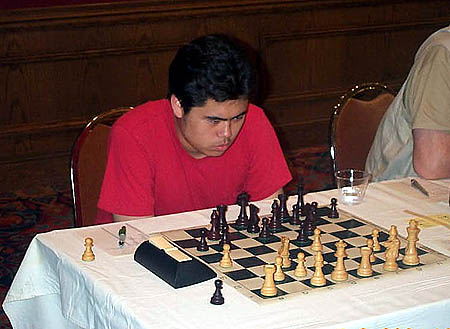
GM Hikaru Nakamura at the 2004 World Open.
Photo by Daaim Shabazz
One of the other attractions of the World Open is that top players were attracted to the tournament and occasionally a Chinese or Indian delegation of several players would show up. Times have changed, and the top 100 GMs are not taking a special trip to come to the World Open. There are several reasons, but it is simply a tougher tournament to play in given the expense and the amount of preparation everyone is doing at all levels. Lastly, some foreign players complain about the lack of professional conditions in American tournaments.
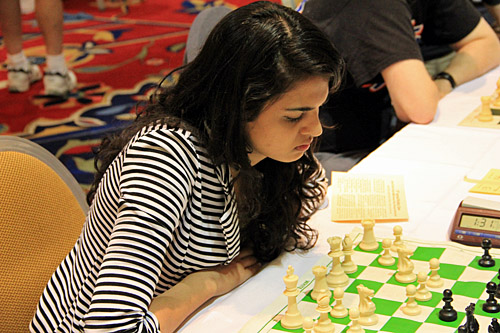 India’s IM Tania Sachdev was one of the members of the large Indian contingent in 2012. Photo by Daaim Shabazz
India’s IM Tania Sachdev was one of the members of the large Indian contingent in 2012. Photo by Daaim Shabazz
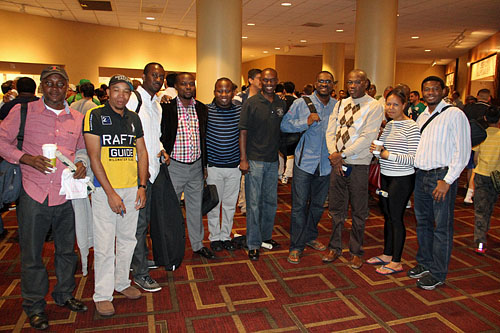
Nigerians & two friends at 2014 World Open (L-R) Charles Campbell, Iyobebe Owolo Hanson, Precious Acheru, Efemuai Odafe Benedict, Uche Agu, Daaim Shabazz, Lolomari E. George, Robert Asibor, Vanita Young and Paul Obiwame.
Strong GMs used to be able to show up at the World Open and be reasonably sure they’d take home a prize. Today there is not enough incentive to justify such a long trip if one has to compete against juniors with fully-indexed databases, GM coaches and their 3500-rated engines.
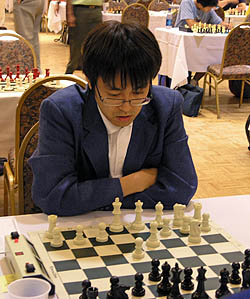
Yoshiru Habu at 2006 World Open
Photo by Daaim Shabazz
There used to be the air of camaraderie between GMs and other players. In the past ten years, rarely do you see GMs enter the skittles room and analyze because everyone will discuss at the board briefly and then go input the game in the database as part of the preparation for later rounds. It was an absolute marvel to see two Grandmasters conducting a postmortem analysis. With so much emphasis on computer preparation, there seems to be less interaction.
In years past, the interaction was fairly easy and you had a chance to meet some interesting people. In 2006, Yoshiru Habu played in the World Open. If you don’t know who he is, he is a many time World Champion of shogi. In fact, that is precisely how Maurice Ashley described him when he mentioned playing Habu in another tournament. “He’s the Kasparov of shogi.” At that tournament, I asked him for an interview, and he graciously accepted.
Yoshiru Habu at the 2006 World Open
So has the magic been lost? Well, that is not a “yes” or “no” question. Let’s say the magic is displayed a bit differently. Before engines became an essential tool of tournament players, the vast experience of a Grandmaster-level player was enough to wade through the venomous Swiss system.
“You can’t play this way anymore. You can’t bluff a computer. Everybody works with a computer now, and defense techniques are so improved. It’s no wonder that my peak came at a time when computers were not strong yet.”
~Alexander Shabalov
There was a time in the U.S. when many of the top players were veteran emigres from the former Soviet Union, and they dominated many of the open tournaments for nearly two decades. There were many perfunctory draws given, but a new generation of players arose. Hikaru Nakamura was one such brash player who came with a “kill or be killed” mentality in the mid-2000s. No easy draws! As there was more reliance on computer preparation, many from the old guard had problems adapting.
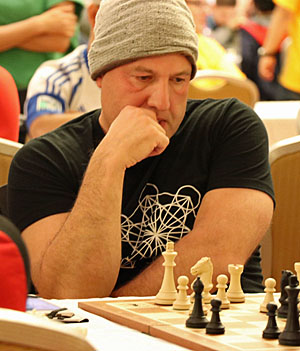
Alexander Shabalov at 2019 World Open
Photo by Daaim Shabazz
Now everyone has a chess engine, but there are other ways players are trying to find balance in chess. I recently read an article about Alexander Shabalov and his preparation for the U.S. Senior Invitational. Everyone who has been playing in U.S. tournaments for at least the last ten years will know “Shabba” and his collection of attacking gems. However, he has had to seek a different path to regain the magic.
His regiment involves immersing himself in a sensory deprivation tank for deep meditation and yoga sessions. Shabalov was known for his effective play in Swiss systems and adopted a swashbuckling, tactical style in the tradition of Latvian legend and former World Champion, Mikhail Tal. Here is what he said:
“You can’t play this way anymore,” Shabalov said. “You can’t bluff a computer. Everybody works with a computer now, and defense techniques are so improved. It’s no wonder that my peak came at a time when computers were not strong yet.”
“It’s a young person’s game now,” Shabalov said. “Because of computers, you don’t need a coach anymore.”
“I wish I was born 50 years later,” said Shabalov. “Now is a really exciting time to be a young chess player because the sky is the limit. There are no restrictions. You might be born in a godforsaken place, but you can still teach yourself how to play. One of the strongest players in the United States, Wesley So, is from a very poor family in the Philippines. He became the No. 2 chess player in the world.”
Amazing and insightful. Of course, you still need more than a computer to become a strong player, but the example of So is appropriate. What is intriguing is that you have a former U.S. Champion talking about the changes of tournament play in the U.S. and he is 100% correct.
Young players have also become incredibly stout defenders. During the 2015 World Open, Marc Esserman was showing a game he played months earlier against Awonder Liang. Esserman wrote the famous book on the Morra Gambit, Mayhem in the Morra. As Liang showed in their encounter, such mayhem at the expense of black is not going to come easily.
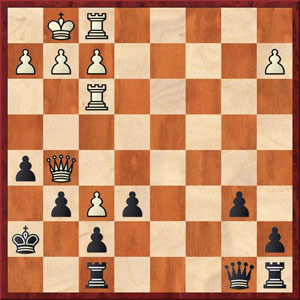
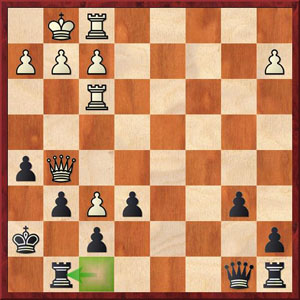
In the aforementioned game, Marc Esserman essayed the Morra Gambit against 12-year old Awonder Liang months earlier at the Philadelphia Open. Black declined and the game turned into a c3 Sicilian. White still got a vicious attack and it appears black is being mated by Rf3-h3xh5. (diagram 1) What would you play to stave off the attack? Looks grim. Marveling at Liang’s defensive skills, an animated Esserman banged down the computeresque 26…Rg8! (diagram 2) It was not a one off move since the young phenom had to foresee this attack developing. (GAME)
I have witnessed a number of norms earned at World Open including one by IM Stephen Muhammad who seemed to shine at the World Open tournament. Of course, Emory Tate would always produce at least one memorable game during the World Open (see 2007 World Open game). These days, it is the youth who are challenging GMs and gaining attention for their World Open Magic. Jeffery Xiong shocked Grandmasters to win the 2015 Chicago Open and was the co-winner of this year’s World Open tournament with Le Quang Liem.
I have also watched other players grow from scholastic players into young adults. I remember seeing both Nakamura and Fabiano Caruana at various World Opens sharpening their fighting skills. Now it is horde of young players like Xiong. One is amazed that players no longer fear or defer a point to Grandmasters. At the recent World Open I saw IM Joshua Sheng battle Cuban GM Lazaro Bruzon in Q+Q+3P vs. Q+R+B+N+P. The game attracted a huge crowd and Sheng looked as cool as a cucumber.
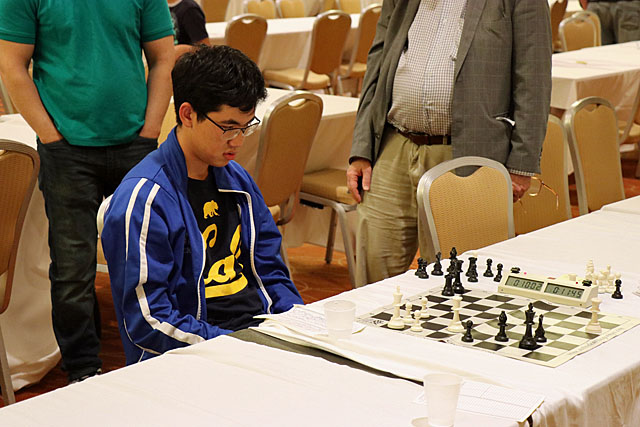
IM Joshua Sheng
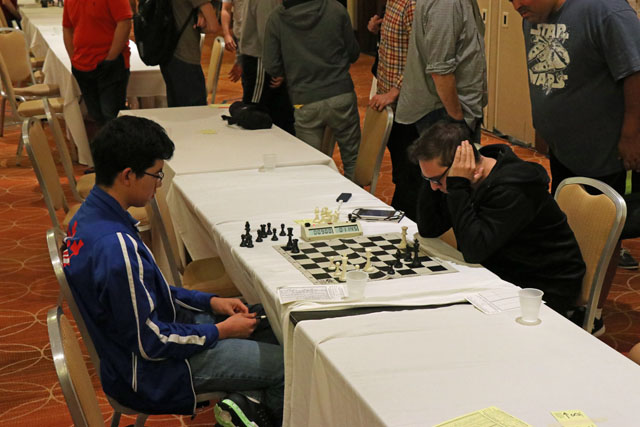
Tense battle… Sheng on the move, but Bruzon bearing down!
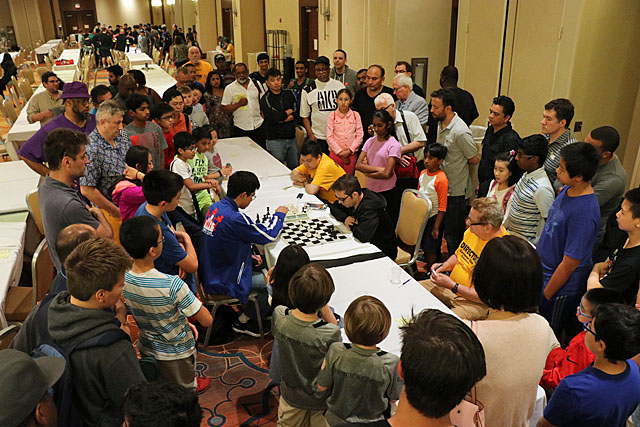
A large crowd watches the action.
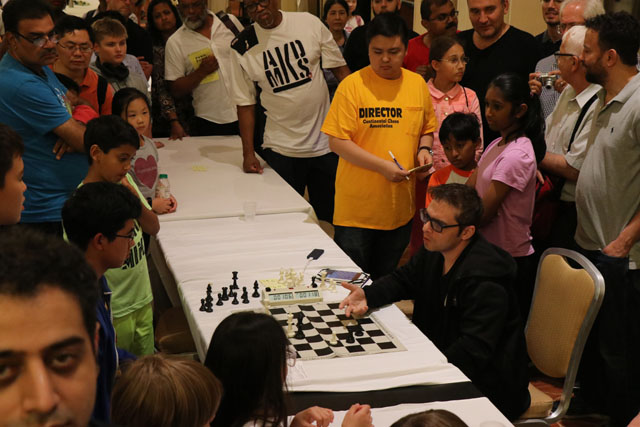
The game was drawn!
What does this mean? Chess magic is still in Philadelphia on 4th of July weekend. There are some issues that need attention. Firstly, the noise level is too much. With half of the tournament consisting of scholastic players, there needs to be more of an effort to control the noise right outside the tournament hall. The playoff game between Jeffery Xiong and Le Quang Liem was played amidst a noise-filled hall with a tournament director shouting instructions for the blitz tournament.
Secondly, there needs to be enforced guidelines for parent/coach interaction with their children/students during competition. Unlike scholastic tournaments, parents are allowed to remain in the tournament hall, and stand by the boards. These relationships are crucial to the child’s development, but in competitions, there has to be some boundaries.
There was an unfortunate situation at 2016 Philadelphia Open of a parent following a player into the bathroom they suspected to be cheating. This parent allegedly peeked into the stall! When the player emerged, they questioned them about a phone. Strangely, his child was not the opponent and he had no official capacity to question the boy. Let’s ensure that these parent-player or coach-player interactions meet acceptable guidelines.
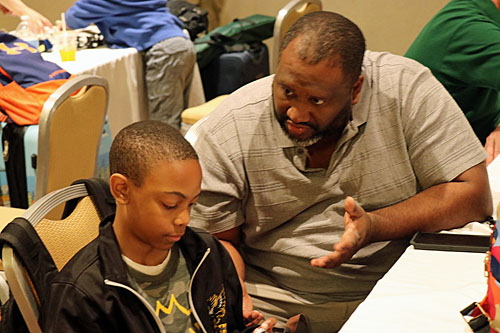
THE RIGHT WAY
Coach Tyrell Harriott giving words of wisdom to his player, Isiah.
Photos by Daaim Shabazz/The Chess Drum
It may very well be that the World Open is a totally different tournament with the amount of junior players it has now. It has a different feel, but that’s fine. We want children to play, but we also want more adults playing. Let’s ensure that we keep the tournament adult-friendly as well. That way legendary players like Larry Gilden and John Fedorowicz will come back to play next year.
What is beautiful about the World Open is that memories are formed and history is being made. Everyone has the chance to bring their magic to the World Open. Whether that is a beautiful game, a strong result, a handsome prize or simply meeting a lot of great people. However you define your mission, let us make magic!
See you next year!
Tournament Website: https://chessevents.com/worldopen/
PGN Games: https://www.thechessdrum.net/games/worldopen2019.pgn
World Open (Drum Coverage): 2019, 2018, 2017, 2016, 2015, 2014, 2013, 2012, 2011, 2010, 2009, 2008, 2007, 2006, 2005, 2004, 2003, 2002, 2001

